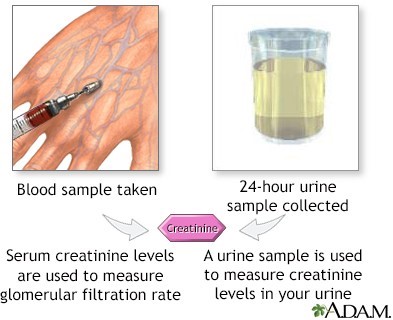Before administering an antibiotic that can cause nephrotoxicity, which laboratory value is most important for the practical nurse (PN) to review?
Serum calcium
Serum creatinine
Hemoglobin and Hematocrit
White blood cell count (WBC)
The Correct Answer is B
Serum creatinine is the most important laboratory value to review before administering an antibiotic that can cause nephrotoxicity. Nephrotoxicity is an alteration in the function of the kidney due to exposure to certain drugs or toxins.
It can be assessed by measuring the glomerular filtration rate (GFR), which is the rate of clearance of a substance from the blood by the kidneys. Serum creatinine is a waste product of muscle metabolism that is freely filtered by the glomeruli and not reabsorbed or secreted by the tubules.
Therefore, it is a reliable indicator of GFR and renal function. An increase in serum creatinine indicates a decrease in GFR and renal function, which may be caused by nephrotoxic drugs.
The other laboratory values are not directly related to nephrotoxicity or GFR:
- Serum calcium: This may be affected by renal function, but it is not a sensitive or specific marker of nephrotoxicity. It may be altered by other factors such as vitamin D, parathyroid hormone, and bone metabolism.
- Hemoglobin and hematocrit: These may be affected by renal function, but they are not sensitive or specific markers of nephrotoxicity. They may reflect the erythropoietin production by the kidneys, which stimulates red blood cell production in the bone marrow. However, they may also be influenced by other factors such as blood loss, hydration status, and iron deficiency.
- White blood cell count (WBC): This is not related to nephrotoxicity or GFR. It may reflect the presence of infection or inflammation, which may be a cause or a consequence of renal impairment, but it is not a direct measure of renal function.

Nursing Test Bank
Naxlex Comprehensive Predictor Exams
Related Questions
Correct Answer is C
Explanation
Choice A rationale:
Discuss the character of labor from endogenous vs. exogenous oxytocin. While it is important to educate the client about the difference between endogenous (naturally occurring) and exogenous (administered) oxytocin, this information may not address the client's primary concern. The client is refusing the prescribed oxytocin infusion and wants a "natural" delivery. Therefore, discussing alternative ways to support her birth plan is more pertinent.
Choice B rationale:
Ask the healthcare provider to discuss the issue with the client. Involving the healthcare provider in the discussion is a reasonable step, but it should not be the first action taken. The nurse can initiate a conversation with the client to explore her concerns and preferences before escalating the issue to the healthcare provider.
Choice C rationale:
Discuss alternative ways to support the client's birth plan. This is the correct choice because it directly addresses the client's refusal of the oxytocin infusion and desire for a "natural" delivery. Exploring alternative methods for inducing or facilitating labor in a way that aligns with the client's birth plan is essential.
Choice D rationale:
Explain the indications for induction related to post-term pregnancy. Explaining the indications for induction is important for educating the client about the medical reasons behind the prescribed treatment. However, this information may not immediately address the client's refusal of the oxytocin infusion. The nurse should first explore the client's concerns and preferences regarding her birth plan.
Correct Answer is A
Explanation
Choice A rationale:
The client's statement, "I should avoid foods that are high in vitamin K," indicates an understanding of the medication. Warfarin is an anticoagulant medication that works by inhibiting vitamin K-dependent clotting factors. Consistent intake of vitamin K-containing foods helps maintain a stable INR (International Normalized Ratio) and warfarin's effectiveness. Clients on warfarin should be educated about avoiding drastic changes in their vitamin K intake.
Choice B rationale:
Taking warfarin with food or on an empty stomach doesn't significantly impact its efficacy. Therefore, this statement is not indicative of the client's understanding of the medication.
Choice C rationale:
The statement "I should report any unusual bleeding or bruising to my provider" is important but doesn't specifically reflect an understanding of warfarin. It's a general caution for anyone taking anticoagulants.
Choice D rationale:
While it's important to avoid excessive use of medications like aspirin that can increase the risk of bleeding, this statement doesn't directly demonstrate an understanding of warfarin itself.
Whether you are a student looking to ace your exams or a practicing nurse seeking to enhance your expertise , our nursing education contents will empower you with the confidence and competence to make a difference in the lives of patients and become a respected leader in the healthcare field.
Visit Naxlex, invest in your future and unlock endless possibilities with our unparalleled nursing education contents today
Report Wrong Answer on the Current Question
Do you disagree with the answer? If yes, what is your expected answer? Explain.
Kindly be descriptive with the issue you are facing.
